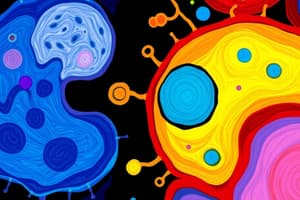Podcast
Questions and Answers
Which type of transport does not require additional energy input in animal cells?
Which type of transport does not require additional energy input in animal cells?
- Endocytosis
- Osmosis
- Diffusion (correct)
- Active transport
What is the primary source of energy for active transport in animal cells?
What is the primary source of energy for active transport in animal cells?
- Oxygen
- ATP (correct)
- Carbon dioxide
- Glucose
What is the main function of carrier proteins in animal cell transport?
What is the main function of carrier proteins in animal cell transport?
- Transporting ions only
- Allowing simple diffusion
- Accommodating polar molecules and charged particles (correct)
- Facilitating endocytosis
Which process involves the engulfing of extracellular components followed by lysosomal degradation inside animal cells?
Which process involves the engulfing of extracellular components followed by lysosomal degradation inside animal cells?
What is the primary function of transport channels in animal cells?
What is the primary function of transport channels in animal cells?
Which type of transport enables the exchange of materials between extracellular fluid and intracellular compartments in animal cells?
Which type of transport enables the exchange of materials between extracellular fluid and intracellular compartments in animal cells?
What is the main function of exocytosis in animal cells?
What is the main function of exocytosis in animal cells?
How does insulin act as a signaling molecule in cells?
How does insulin act as a signaling molecule in cells?
What is a key aspect supported by cell transport mechanisms in animal physiology?
What is a key aspect supported by cell transport mechanisms in animal physiology?
Which cellular process requires the coordinated action of transport systems for efficient signal transmission among nerve cells?
Which cellular process requires the coordinated action of transport systems for efficient signal transmission among nerve cells?
What tools do learners equip themselves with by understanding cellular transport in animal life?
What tools do learners equip themselves with by understanding cellular transport in animal life?
What is the role of balance maintained between and within cells in animal life?
What is the role of balance maintained between and within cells in animal life?
Flashcards are hidden until you start studying
Study Notes
Exploring Cellular Transport in Animal Life via IGCSE Biology
When delving into IGCSE Biology, the world of cellular transport emerges as a central concept vital across various species, particularly animals. To better grasp this dynamic facet of biology, let's explore the mechanisms behind transport in animal cells according to the Cambridge International Examination Syntax 2023-2024 curriculum:
Types of Transport
Animal cells employ two primary methods of transport, active and passive transportation. Active transport relies upon energy derived from ATP and is essential for maintaining ion concentrations inside and outside of cells. Passive transport does not require additional energy input and entails simple diffusion or osmosis.
Proteins Facilitating Transport
Channels and carrier proteins play pivotal roles in regulating movement across animal cell membranes. Channels allow passageways for water and ions, whereas carrier proteins contain binding sites capable of accommodating polar molecules and charged particles. Both types of transporters enable the exchange of materials between the extracellular fluid and intracellular compartments.
Transports Occurring Inside Animal Cells
Endocytosis refers to the engulfing of extracellular components, followed by lysosomal degradation within cells. Endocytotic pathways include phagocytosis, pinocytosis, and receptor-mediated endocytosis. In contrast, exocytosis involves releasing vesicles containing waste products or newly synthesized molecules into the extracellular space.
Relationship Between Transport Mechanisms and Cell Function
Cell transport mechanisms support crucial aspects of animal physiology, contributing significantly to nutrient absorption, hormonal regulation, and neuron communication. For example, insulin acts as a signaling molecule facilitated by transmembrane protein interactions, allowing cells to uptake glucose via glucose transporters. Similarly, neurotransmitter release requires the coordinated action of several transport systems to ensure efficient signal transmission among nerve cells.
Key Takeaways
Understanding cellular transport in animal life provides students with valuable insights into essential cellular mechanics. By grasping fundamental concepts regarding channels, carrier proteins, and the balance maintained between and within cells, learners equip themselves with tools necessary for excelling in IGCSE Biology and beyond.
Studying That Suits You
Use AI to generate personalized quizzes and flashcards to suit your learning preferences.




